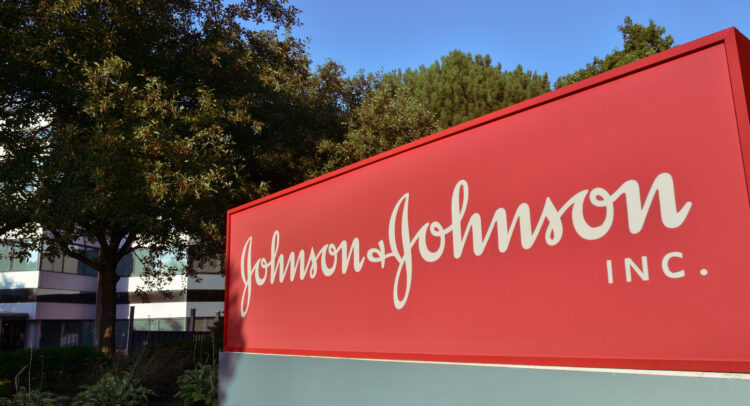Johnson & Johnson (NYSE:JNJ) is currently trading at a decade-low forward P/E ratio. This is particularly interesting since the healthcare behemoth rarely trades at a discount. With the company boasting six decades of consecutive annual dividend increases and the stock featuring a multi-year high yield following its recent decline, the buying opportunity many dividend growth investors have been waiting for may have finally emerged. Johnson & Johnson’s investment case now offers a greater degree of margin of safety than in prior years. Accordingly, I am bullish on the stock.
What Drove the Decline in Johnson & Johnson Shares?
Johnson & Johnson stock has declined by about 10% over the past year. This is not a significant decline relative to how most stocks have performed in this volatile market environment. However, for a stock whose share price tends to perform with little volatility over the years, the recent decline is certainly worth paying attention to. In my view, the main driver behind Johnson & Johnson’s decline is investors demanding a higher yield from the stock as a result of the hasty interest rate hikes that have occurred in recent months.

Johnson & Johnson stock has been primarily held by income-oriented investors and funds who praise the company’s multi-decade dividend growth streak and seek stability. However, with T-bills now offering significant yields, the cost of holding Johnson & Johnson (i.e., the stock’s cost of equity) has risen greatly. In other words, the opportunity cost of holding Johnson & Johnson holding is now much wider relative to a couple of years back when interest rates were hovering near 0%.
Johnson & Johnson’s Financial Performance Remains Rock-Solid
Despite the ongoing macroeconomic landscape taking control of Johnson & Johnson’s stock price, we have to recognize that its financial performance remains rock-solid.
The company ended Fiscal 2022 on a high note, with total revenues for the year growing 1.3% to $94.9 billion. The relatively humble growth was due to unfavorable currency translations, as well as a decline in the sales of COVID-19 vaccines following their inflated sales in 2021. In constant currency and excluding vaccine-related sales, revenues for the year actually grew by 6.2%, in line with Jonhson & Johnson’s tendency to grow its sales in the mid-single digits.
Further, adjusted earnings per share for the year reached an all-time high of $10.15, up 3.6% year-over-year, while management’s guidance came in rather optimistic. In Fiscal 2023, the company expects to achieve adjusted earnings per share between $10.40 and $10.60, the midpoint of which implies similar growth of about 3.5%.
Of course, this is not a fantastic pace of growth, but it does illustrate Johnson & Johnson’s resiliency, which can drive earnings growth even during a highly uncertain and inflationary market environment.
Why Does the Stock’s Decline Present a Noteworthy Opportunity?
Johnson & Johnson’s recent decline presents a noteworthy opportunity for a key reason — that is, despite the earlier argument’s validity about the cause of its stock decline, we have to incorporate the fact that Johnson & Johnson is a high-quality company whose earnings and dividends continue to grow at a satisfactory pace. In fact, the recent stock price decline, combined with the company’s earnings hitting new all-time highs and the dividend increasing gradually, has not only caused JNJ’s dividend yield (2.94%) to reach the higher end of its seven-year average but also its forward P/E ratio to tighten considerably.
For context, JNJ stock’s dividend yield over the past seven years (excluding a very brief period of time during the COVID-19-driven “flash crash” in March of 2022) has hovered between 2.3% and 3.0%. Hence, with Johnson & Johnson currently yielding nearly 3%, investors can take advantage of a relatively high dividend yield attached to the stock.
In the meantime, the midpoint of management’s adjusted earnings-per-share outlook for Fiscal 2023 points to $10.51, implying a 3.5% increase from last year’s record earnings. The combination of record forward earnings projections against a declining stock price has driven Johnson & Johnson’s forward P/E to 14.6. Again, excluding a brief period during March 2020, this is the lowest forward P/E the stock has traded at in just over 10 years. Therefore, Johnson & Johnson now trades with a notably higher margin of safety compared to its recent history.
Is JNJ Stock a Buy, According to Analysts?
Turning to Wall Street, Johnson & Johnson has a Moderate Buy consensus rating based on three Buys and six Holds assigned in the past three months. At $180, the average Johnson & Johnson stock forecast implies 17% upside potential.

The Takeaway
Dividend growth and income-oriented investors, in general, often argue that high-quality companies of the caliber of Johnson & Johnson rarely go on sale. The stock’s recent decline may finally be offering the long-awaited chance for such investors to capitalize on.
The company’s earnings continue to grow steadily, and so have its dividends, resulting in a multi-year-high dividend yield and multi-year-low valuation. Thus, the stock’s investment case is now shielded by a relatively wider margin of safety, which can be a great advantage in such an uncertain market.
Simultaneously, the stock’s humble valuation leaves much room for a potential multiple expansion toward its historical average (P/E of 15x-20x), signaling the possibility of notable upside, moving forward. Wall Street’s estimates seem to agree with this positive outlook as well.









